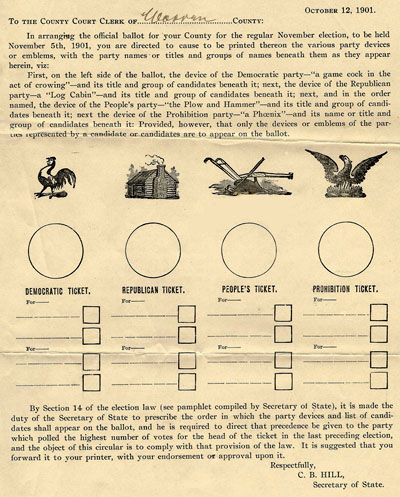
According to the Louisville Courier-Journal, Democrat James Franklin Clay had made an admirable showing in Washington as representative for Kentucky’s Second Congressional District. When the Henderson lawyer sought re-election in 1884, however, he faced a challenge from within his own party. James Knox Polk Laffoon was a relatively unknown Madisonville attorney, but “Polk” (his nephew Ruby Laffoon would become Kentucky’s governor in the 1930s) soon charmed the voting public with his “quiet, yet honest and open” demeanor. And he had a dramatic backstory: as a youth of 17, he had entered the Confederate Army and endured two stints as a prisoner of war. During a forced march from Bowling Green, a veteran recalled seeing “the gallant boy soldier” trudging through the rain and mud after giving up his horse to a sick, weak comrade.
Laffoon’s dogged campaigning undercut Clay’s previously unassailable position. At the party’s convention, ballot after ballot failed to give either man the nomination. Laffoon, it was reported, could have broken through with “a little trickery” by courting an “uninstructed” delegation from a county where the voters supported his opponent, but resolved instead to “go down true” rather than risk staining his honor. Finally, the convention resolved to hold a primary election to break the deadlock.
In the primary held on October 13, 1884, Clay carried his own Henderson County by a large majority, but across the district he lost to Laffoon by about 300 votes. Several days later, the Courier-Journal correspondent assured readers that Clay’s supporters were “reconciled to their defeat, and will heartily support Polk Laffoon, who they credit with gallantly winning the fight.”
On the ground, it was a little grittier. From McLean County, where Clay had eked out a 75-vote majority, a disappointed George Priest reported on his efforts to bring voters into the fold with incentives of the liquid kind. In accordance with Clay’s instructions, the Livermore merchant had enlisted a local saloon-keeper “to run his Barroom in your interest on the day of [the] primary Election.” Unfortunately, the campaign of the “boy soldier” had responded in kind, Priest griped, as the town’s “other two Barrooms were thrown wide open for Laffoon.” Beaten at his own game, he “regretted exceedingly that such a man should be elected.” All that was left was to settle accounts: $25 to the pro-Clay barroom keeper, and $12 to Priest for out-of-pocket expenses. Oh, and one more thing, wrote Priest to the soon-to-be-lame-duck Congressman: “If there is anything ‘Soft’ in the way of a Government position that I am competent to fill please remember me.”
George Priest’s letter is part of the Manuscripts & Folklife Archives of WKU’s Department of Library Special Collections. Click here to access a finding aid and scan of the letter. For more collections on election campaigns, search TopSCHOLAR and KenCat.


